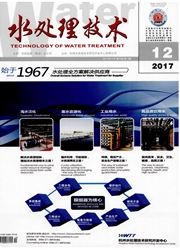

 中文摘要:
中文摘要:
采用5个并联运行的SBR反应柱培养好氧颗粒污泥,分别用0、1、3、5 mg/L和10 mg/L Cr(VI)对各反应柱中的颗粒污泥长期驯化65 d,此后改变各反应柱中Cr(VI)为30 mg/L进行12天冲击实验。实验结果表明,经10mg/L Cr(VI)驯化后的好氧颗粒抗冲击负荷能力最强,其COD和NH4+-N去除率略有降低,分别由90.46%和85.13%下降到88.53%和82.88%,其污泥浓度仅由4 660 mg/L变为4 460 mg/L,EPS分泌量仅增加39.99%,表面官能团未发生明显变化。总体来看,驯化浓度越高,颗粒污泥污对高浓度Cr(VI)冲击的抵御能力越好。
 英文摘要:
英文摘要:
The aerobic granulear sludge(AGS) was successfully cultivated in five identical sequencing batch reactors(SBR) for 40 days. In the following65 days, 0 mg/L, 1 mg/L, 3 mg/L, 5 mg/L and 10 mg/L Cr(VI) were spiking into the reactors repectively. In order to improve the adaptation of AGS to Cr(VI).In the next 12 days, the concentration of Cr(VI) in all reactors were changed to 30 mg/L to investigate the anti-shock loading ability of AGS. The results showed that the AGS with the 10 mg/L Cr(VI) pre-cultivation obtained the highest anti-shock loading ability. Its removal rates of COD and NH4+-N changed from 90.46% and 85.13% to 88.53% and 82.88%; mass concentration of mixed liquid suspended solids(MLSS) decreased from 4 660mg/L to 4 460 mg/L and the higher settleable sludge was obtained in the reactor.At the same time, the microbial secretion of extracellular polymeric substances(EPS) only increased by 39.99% with little change of surface functional groups. In brief, the higher pre-cultivation concentration of Cr(VI)stimulate the better tolerance and anti-shockloading ability of AGS to the high concentration Cr(VI) for their small changes in pollutants removal rates,sludge stability and microbial activity.
 同期刊论文项目
同期刊论文项目
 同项目期刊论文
同项目期刊论文
 期刊信息
期刊信息
